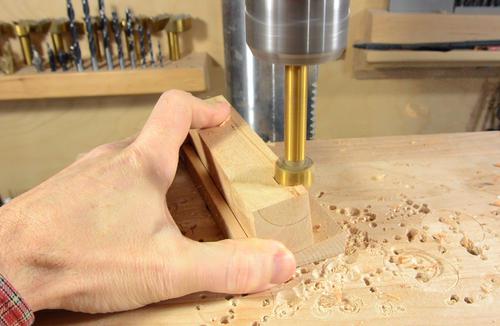 I put the workpiece on an 8-degree inclined ramp to hold it at the correctt
angle. The holes all need to be drilled in such a way that the bottom edge
is 1.87mm (or about 1.9mm) from the bottom edge of the block.
I put the workpiece on an 8-degree inclined ramp to hold it at the correctt
angle. The holes all need to be drilled in such a way that the bottom edge
is 1.87mm (or about 1.9mm) from the bottom edge of the block.
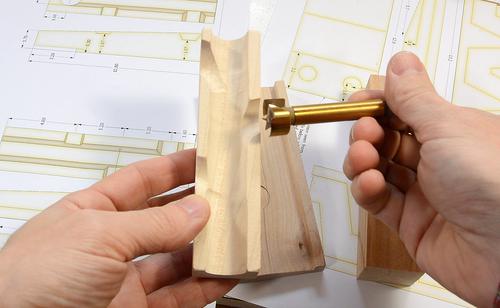 When I first built these ramps,
I used my router pantograph
to carve out the main track and side entrance holes in one go.
A pantograph really is the fastest way to cut those, but building the
pantograph and setting it up takes time. So I wanted to figure out
another way to make them.
When I first built these ramps,
I used my router pantograph
to carve out the main track and side entrance holes in one go.
A pantograph really is the fastest way to cut those, but building the
pantograph and setting it up takes time. So I wanted to figure out
another way to make them.
I wanted to figure out a less tool-intensive way to make the ramps, so this time I cut them out with a Forstner bit.
 I put the workpiece on an 8-degree inclined ramp to hold it at the correctt
angle. The holes all need to be drilled in such a way that the bottom edge
is 1.87mm (or about 1.9mm) from the bottom edge of the block.
I put the workpiece on an 8-degree inclined ramp to hold it at the correctt
angle. The holes all need to be drilled in such a way that the bottom edge
is 1.87mm (or about 1.9mm) from the bottom edge of the block.
These holes are tricky to drill. You need to hold the workpiece very securely because the center of the drill may or may not be in the wood. Do not attempt this with a spade bit. And don't even think bout wearing gloves - that could go badly. If you are afraid, then jig the piece up in a drill press vise.
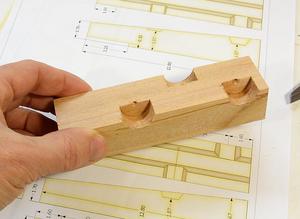 Another alternative would be to cut the notches by hand with a chisel after
the groove is routed in the top.
Another alternative would be to cut the notches by hand with a chisel after
the groove is routed in the top.
At right, the three entry holes.
Before cutting the slant on the face, It's best to drill the holes from the bottom Before cutting the slant on the top (easier to support the workpiece). The holes on the bottom allow the piece to interlock with the coupler pieces, which helps keep the tracks from sliding apart when the marbles bounce along them.
The best way to get the holes precise is to use a caliper or marking gauge to accurately mark the hole locations, then use an awl to punch a divot at the exact locations. The divot will guide the point of the forstner bit to the exact spot.
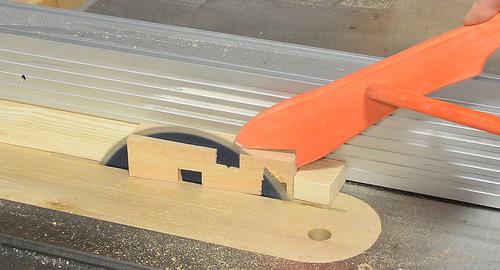
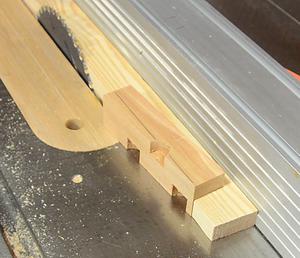 With the holes drilled on the bottom, time to cut the slope on the top.
With the holes drilled on the bottom, time to cut the slope on the top.
I made a simple "tapering jig" by cutting an angled cutout on the side of a board that the piece fits into. You could cut the slope on a bandsaw as well, but the cut is not as clean or accurate.
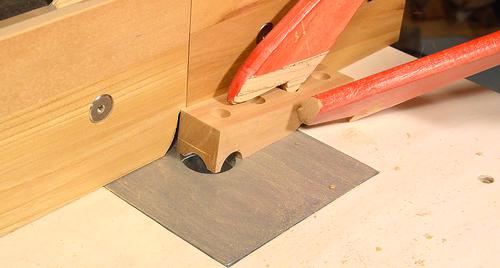 Cutting the main channel on the router table. This needs to be at just the
right depth. If it's too deep, the exit point of the ramp may end up lower than
the entry point for the next ramp.
If it's too shallow, there might be a slight step-up at the entry holes.
Cutting the main channel on the router table. This needs to be at just the
right depth. If it's too deep, the exit point of the ramp may end up lower than
the entry point for the next ramp.
If it's too shallow, there might be a slight step-up at the entry holes.
I found, with the piece as shown, the missing material for the first entry hole caused the piece to get pulled forward by the router. So be sure to press down on it hard, with push sticks.
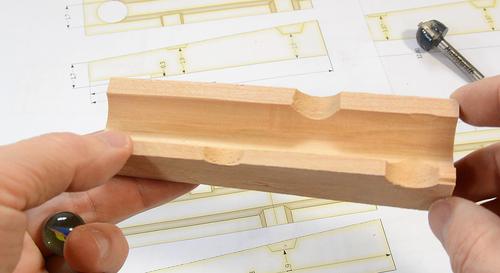 finished ramp piece. Unlike the one made with the pantograph, the entry holes are
all straight instead of angled down-slope. This causes the marbles to go down
a little bit slower, which may or may not be a good thing.
finished ramp piece. Unlike the one made with the pantograph, the entry holes are
all straight instead of angled down-slope. This causes the marbles to go down
a little bit slower, which may or may not be a good thing.
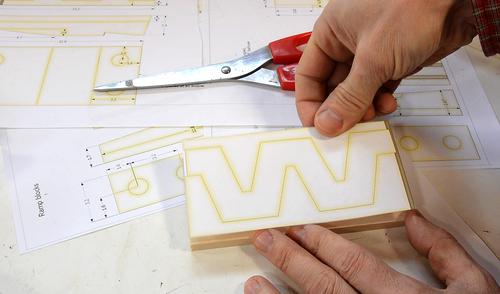 I had previously milled the zigzag pieces
out of a solid piece of wood using my pantograph. Other than the pantograph,
I couldn't think of a good way of cutting these with a router.
I had previously milled the zigzag pieces
out of a solid piece of wood using my pantograph. Other than the pantograph,
I couldn't think of a good way of cutting these with a router.
So this time, I built the zigzag blocks up in layers.
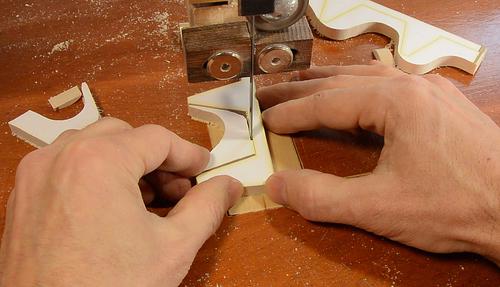
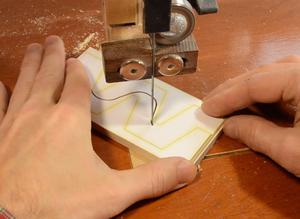 I made one curvy cut between the two halves, then worked on each half to cut the
channel square.
I made one curvy cut between the two halves, then worked on each half to cut the
channel square.
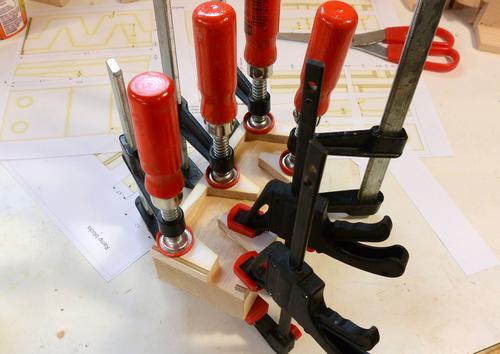 These were then glued onto a thicker block of wood.
These were then glued onto a thicker block of wood.
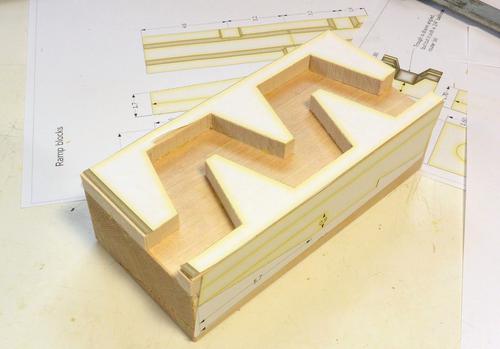 After that, the side template is glued on. The dark edge of the
top template corresponds to the bevel that is visible from above.
After that, the side template is glued on. The dark edge of the
top template corresponds to the bevel that is visible from above.
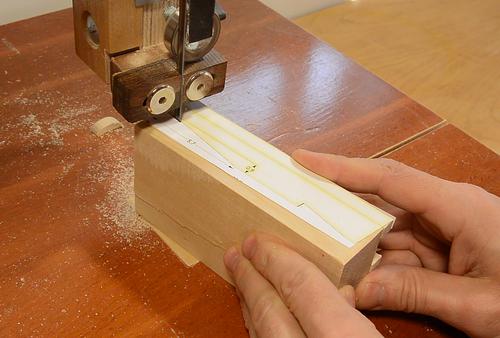
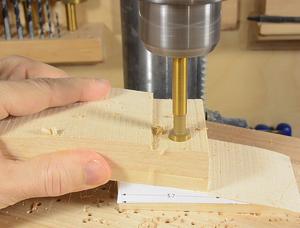 I put the block on its side and cut it out on the bandsaw.
I put the block on its side and cut it out on the bandsaw.
I then used some of the inclined scraps from cutting out that block to support it at the correct angle for drilling the alignment holes in the bottom.
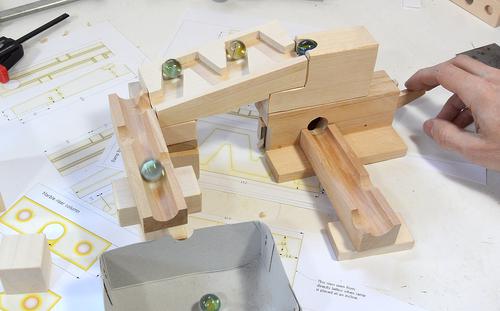 And finally, testing the blocks with the zigzag and blocks with the marble pump.
And finally, testing the blocks with the zigzag and blocks with the marble pump.
Back to the main woodworking website.